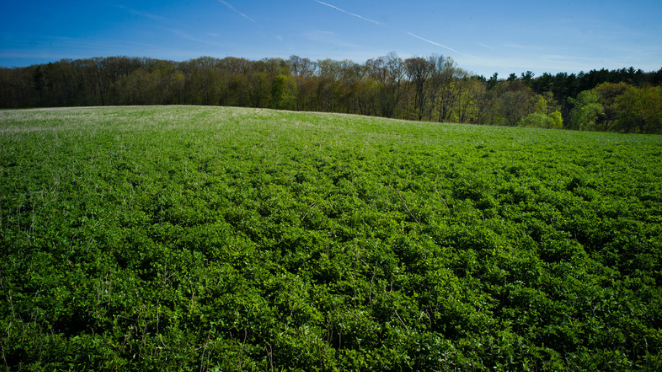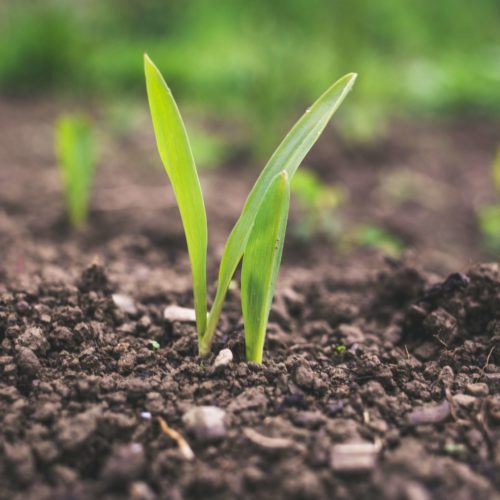As dairy prices plummet, policymakers strive to keep farms afloat
Former New Hampshire Agriculture Commissioner Lorraine Stuart Merrill describes the challenges dairy farmers are confronting amid the current pandemic. This is the third installment in a CSG East series.

Former New Hampshire Agriculture Commissioner Lorraine Stuart Merrill on the Stuart family farm in Stratham, New Hampshire. Credit: Susan Lirakis
Lorraine Stuart Merrill has spent decades steeped in agriculture – as a farmer, reporter, and the state’s former top agricultural official – and she has never experienced anything that resembles the crisis afflicting the sector amid the COVID-19 pandemic.
“Nothing like this has happened in our lifetimes,” said Merrill one recent morning, just after calling in a request for credit to pay bills for her family’s dairy farm in Stratham, New Hampshire. “The whole supply chain is just in chaos.”
The chaos is hurting farmers of all kinds, from small-scale New England producers to massive midwestern growers and ranchers. Seemingly overnight, demand dried up from restaurants, schools, and other large purchasers as state lockdowns took effect. Many producers, running out of places to store their products or money to feed their animals, have had to resort to the unthinkable: dumping milk, euthanizing chickens, culling herds, even forcing pigs to abort their fetuses. The bitter irony is that the massive waste has occurred amid a spike in demand for food assistance from the record number of Americans who are out of work.
“There are lots more families that are in need of help than ever before, and we have this mismatch between supply and demand,” said Merrill.
The crisis is the latest blow to a sector that has struggled to turn a profit in recent years, particularly in the New England states. A January 2019 report from a Vermont state agency found that milk prices were below production costs for four years in a row; in 2018, prices slumped to $15.44 per hundredweight, a 10-year low. Last fall, the outlook began to brighten, with reports of $19 per hundredweight. And then the pandemic hit.
“Instead of $19, we’re looking at maybe $11 for May and June,” said Merrill.
Now, many farmers who a few months ago were expecting better times could be facing bankruptcy.
Adding to the hardship are reports showing that dairy exports are down 15 to 17 percent. America’s dairy farmers typically sell 18 percent of their products to foreign markets, though in recent years, producers have confronted strong headwinds. There has been increased competition from milk alternatives made from soy, almonds, and oats; and in 2018, the sector was hit with retaliatory tariffs from Mexico and China on dry-milk and whey products. The two countries account for around 35 percent of U.S. dairy exports.
Congress has allocated stimulus funds to assist farmers, but state officials are urging faster action, and new programs to save the farm economy.
Federal assistance
In a letter to U.S. Department of Agriculture Secretary Sonny Perdue last month, agricultural officials from New Hampshire and six other Northeastern states warned that dairy farmers are facing potential losses totaling $2.85 billion this year from the drop in milk prices alone. The officials urged the agency to set a price floor of $19.50 per hundredweight through June, which is considered to be the break-even price for many dairy farms. The letter also requests a floor for products including butter, nonfat dry milk, and cheddar cheese, and direct payments to dairy farmers. Without federal aid, many farmers may not survive the crisis, they warned.
“With the onset of COVID19 globally, the light has dimmed and may go out for many of our dairy farm families,” the officials wrote.
In a separate letter, officials in New York and Pennsylvania asked USDA for a reimbursement of $3.00 per hundredweight of milk produced during the next three months, which could equal $10,000 per month for the average dairy farm, among other measures.
Under the CARES Act enacted by Congress in March, USDA was given some $49 billion in funding to support local producers suffering negative economic impacts from COVID-19, including $9.5 billion in direct assistance to farmers, though it provided little direction on how the funds will be distributed.
USDA has allocated $2.9 billion for dairy, but the National Milk Producers Association and other groups say that is not enough. In a letter to Secretary Perdue, New York Agriculture Commissioner Richard Ball noted the $2.9 billion represents just 34 percent of USDA’s expected losses for the dairy industry. “The proposed packages do not closely match USDA’s own forecasts of the price reductions that are attributable to the COVID-19 pandemic and the amount allocated to the dairy industry is inadequate,” he wrote.
Congress has also authorized funds to buy surplus food as demand from food banks has surged. Through the Families First Coronavirus Response Act, USDA created a program to purchase and distribute up to $3 billion of agricultural products to food pantries, faith-based organizations, and other nonprofits providing food to those in need, including buying up $100 million a month in each of three different categories: dairy products, fruit and vegetables, and meat. The shipments will be assembled in food boxes and sent to food pantries starting in mid-May.
In addition, last Monday USDA announced that starting in July, it will purchase another $470 million in surplus foods from farmers — including $120 million in dairy products — under the Section 32 program, which is a permanent appropriation established in 1935 to alleviate hunger and stabilize commodity prices.
‘A total waste’
Some policymakers and growers have criticized USDA for being slow to purchase food from farms amid rising food insecurity as unemployment hits record levels. Last month the American Farm Bureau and Feeding America, a nonprofit, requested that USDA set up a voucher program to “deepen the relationship between farmers and food banks,” rather than relying on third parties, whose involvement often lengthens the trip from farm to food pantries.
States have begun to devise their own solutions to assist local farmers and the legions of food insecure households.
New York Governor Andrew Cuomo recently announced a new program that will purchase milk and other products from upstate farms and distribute it to food banks elsewhere in the state, where demand for food has increased by up to 200 percent amid the pandemic.
New York ’s dairy farmers, who typically sell 50 percent of their milk to the food-service sector, have dumped millions of pounds in the last few weeks. Under the program, the state will work with processors to turn the excess milk into cheese, yogurt, and other dairy products for food banks.
“We have people downstate who need food. We have farmers upstate who can’t sell their product,” Governor Cuomo said during his daily press briefing on April 27. “This is just a total waste to me.”

The Stuart Farm. Credit: Cabot Cooperative Creamery
A shrinking number of farms
Even before the COVID-19 crisis, New Hampshire officials were working to support the state’s $1.8 billion dairy market. Milk is the state’s top agricultural product, but like many other states, New Hampshire has lost over a third of its dairy farms over the last decade owing to a mix of factors, including slumping prices, a drop in milk consumption, and competition from non-dairy alternatives. Currently, the state has 94 dairy farms, which support 7,000 jobs, according to Shawn Jasper, the state’s current agriculture commissioner.
In response to competition from regional producers, last fall Governor John Sununu signed legislation creating a program that allows the state’s milk producers to charge a premium of 50 cents per gallon of milk in retail stores, of which 43 cents would go back to dairy farmers, with the remaining 7 cents used to advertise the program. Individual stores would have to agree to participate; Jasper and other agricultural leaders have been urging them to do so.
In the interim, producers are experimenting with innovative ways to get their products to those who need them the most. The University of New Hampshire Cooperative Extension has created an interactive map enabling food access organizations to offer free or low-cost food to the public; and another connects consumers directly with farms. There have also been reports that community-supported agriculture, in which customers pay upfront for a guaranteed supply of vegetables and fruit throughout the season, is gaining in popularity as consumers look for secure, local supply chains of staples. But most dairy farms are not able to capitalize on direct-to-consumer markets because of the investment required in processing and distribution.
A need for creative approaches
Merrill recalled that when she was commissioner, she devised an innovative system to connect producers with food pantries in the state following the loss of the Northeast Interstate Dairy Compact, an agreement among New England states that had raised milk prices to help keep local farmers solvent. The program ended in 2001 after intense lobbying from processors and Midwest dairy producers. New England dairy farmers created a new initiative, called “Keep Local Farms,” to enable consumers to enhance dairy farm income by paying a small premium for milk. The program was unable to generate significant funds, and the money that was raised was allocated to benefit each state’s dairy producers. New Hampshire’s portion was around $7,000.
Merrill had learned that milk was the most requested but least available food at the state’s food pantries, and saw an opportunity to use the funds to feed those in need. The idea was embraced by the Granite State Dairy Promotion board, which represents the state’s producers. Merrill invited H.P. Hood, which has a milk bottling plant in Concord, to join the farmers’ effort. Hood provided a matching contribution, and Cabot Creamery Cooperative — which is part of the Agri-Mark Cooperative, whose members include roughly half of New Hampshire dairy farms — sent a truckload of cheese. In total, thanks to Merrill’s efforts, the New Hampshire Food Bank had some $18,000 in dairy products that it was able to distribute to local food pantries and summer feeding programs.
In the two years since retiring as commissioner, Merrill has found other ways to help communities adapt to changing circumstances. She recently co-authored a book that highlights the state’s aging population – the state is the nation’s second oldest, with a median age of 43 – and warns that failure to attract a young workforce that can have an affordable standard of living could threaten the state’s economy.
The book also explores some of the positive developments in pockets of the state where residents and local officials are creating vibrant communities, and supporting intergenerational households. In Merrill’s family, farming is a multigenerational pursuit; currently, her older son and daughter-in-law are partners and successors on the farm as Merrill and her dairy-farmer husband transition to more supporting roles. Merrill still does the accounts and helps with chores.

Three generations on the Stuart Farm. From left: Lorraine Merrill’s granddaughter, Sammy; Lorraine Merrill; her son, Nathan; her husband, John; her daughter-in-law, Judy; and granddaughter, Hannah. Credit: Cabot Cooperative Creamery
As of May 1, Merrill’s family farm and others in its dairy cooperative are required to cut their milk production by about five percent to help survive the current crisis and avoid the need to dump milk. That requires the family to consider a set of complex decisions, including sending a few cows to “beef” earlier than usual, and adjusting the diets of some of their more than 200 dairy cows to reduce their output. It’s a tricky business, because the diets are scientifically calculated to balance milk production, body condition and health, depending on where the cows are in their lactation cycle, and on available feed supplies. Ramping down production takes time; and when demand improves, ramping back up will be impossible for some cows, depending on their lactation stage.
For now, the focus is on moving forward, and hoping that federal and other assistance programs will be enough to sustain farmers until the economy revives.
“I find it very encouraging to see how many people are really trying to do what they can to help us get through to the other side – and that goes for state legislators and others in state government,” said Merrill. “To them, I say: Thank you.”





